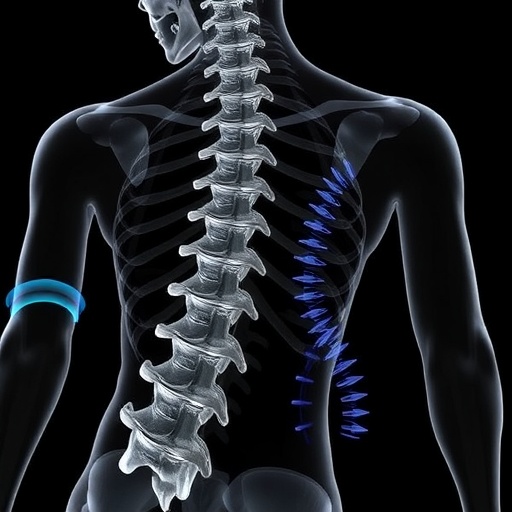
In recent years, the field of biomedical engineering has witnessed significant advancements, particularly concerning the biomechanics of human anatomy and injury prevention in automotive contexts. A recent correction by researchers Kent and Forman sheds light on the critical examination of disc injuries and spine loads during low-to-moderate severity frontal impacts—an area that continues to pose significant risks to vehicle occupants. This brings to the forefront the importance of understanding biomechanical stresses experienced during vehicular accidents.
Frontal impacts are one of the most common types of collisions that occur on the road. When vehicles collide head-on, the forces can lead to various types of injuries, especially in the spine and intervertebral discs. The correction made by Kent and Forman deals with earlier findings that have direct implications for safety regulations, crash testing, and the design of vehicle restraint systems. The ongoing refinement of such studies is vital in advancing our knowledge and protective measures for individuals involved in traffic accidents.
The human spine is a complex structure comprised of vertebrae, intervertebral discs, nerves, and connective tissues that work synergistically to provide stability and support for the body. Among these components, intervertebral discs play a crucial role in absorbing shock and distributing loads across the spine. However, during an automotive collision, especially a frontal impact, the dynamics alter dramatically, exposing these discs to forces they are not structurally designed to endure. Understanding these forces can illuminate why certain injuries occur and the patterns in which they manifest.
In their original study, Kent and Forman provided a comprehensive analysis of the load distributions across the spine during impacts of varying severities. Their measurements indicated a range of forces that could lead to potential disc injuries, particularly in low to moderate severity accidents where occupants may assume safety based on airbag deployment and seatbelt usage. This false sense of security can lead to underestimating the trauma that these impacts can inflict on the spine.
Previous research has inadequately addressed the nuances of spine loads in low to moderate severity situations. Common crash test methodologies often focus on high-severity accidents, neglecting the injuries that occur in less severe impacts. The correction emphasizes that even minor collisions can be detrimental, given the right conditions, as revealed by their findings. This new insight could influence both the design of vehicles and the practices adopted by safety regulators.
The biomechanical implications in this line of research hinge on several key factors, including the angle of impact, the speed of the oncoming vehicle, and the use of corrective measures such as seat belts and airbags. Detailed computational models demonstrate how the interplay of these factors aggravates the load carried by the spine. Discs in the cervical and lumbar regions are particularly susceptible to damage when subjected to abrupt deceleration forces, leading to injury mechanisms that might not be immediately apparent.
In 2025, as anticipated, the published article will delve further into the new findings to explore the relationships among collision dynamics, injury mechanisms, and the anatomical considerations of the spinal column during frontal impacts. It is highly likely that this work will garner attention not only from the biomedical community but also from automotive engineers and policymakers aiming to enhance transportation safety.
The ramifications of this research are crucial. Improved safety standards can stem from a deeper understanding of how collisions affect the human body at various impact levels. If corrections to previous work provide new insights, they can facilitate the development of enhanced safety protocols and innovative automotive technologies. Specifically, vehicle restraint systems may be re-evaluated, potentially leading to designs that better accommodate the biomechanics of the body, thereby reducing injury rates.
Moreover, the education of car manufacturers and policymakers is imperative. They must be made aware of the injury patterns that can arise from ostensibly minor collisions. Incorporating findings from Kent and Forman into educational materials for engineers can drive significant changes in how vehicles are conceptualized, ensuring a more comprehensive approach toward occupant protection in real-world scenarios.
In summary, Kent and Forman’s work offers a pivotal correction to our understanding of spinal injuries related to low to moderate severity frontal impacts. Their findings underline that even minor collisions can have catastrophic results on spinal health, emphasizing the need for worldwide automotive safety standards to be updated to consider these insights. As the automotive industry evolves, so too must our approach to occupant safety, ensuring that advancements in crashworthiness and injury prevention are rooted firmly in research findings and biomechanical evidence.
In conclusion, the importance of collaborative efforts in research and engineering cannot be overstated. As scientists and engineers work hand in hand, real improvements in the protection of vehicle occupants become increasingly tangible. The correction issued by Kent and Forman represents a step forward in understanding the forces at play within our bodies during traffic incidents. As this research continues to unfold, it will pave the way for more effective strategies aimed at safeguarding lives on the road, showcasing how rigorous scientific inquiry can directly contribute to enhanced public safety.
Subject of Research: Disc Injury and Spine Loads in Low-to-Moderate-Severity Frontal Impacts.
Article Title: Correction to: Disc Injury and Spine Loads in Low-to-Moderate-Severity Frontal Impacts.
Article References: Kent, R., Forman, J. Correction to: Disc Injury and Spine Loads in Low-to-Moderate-Severity Frontal Impacts. Ann Biomed Eng (2025). https://doi.org/10.1007/s10439-025-03817-9
Image Credits: AI Generated
DOI:
Keywords: Disc injury, spine loads, frontal impacts, automotive safety, biomechanical engineering.
Tags: advancements in biomedical engineeringautomotive safety regulationsbiomechanical stresses in traffic accidentsbiomechanics of human anatomycrash testing methodologiesdisc injuries in frontal impactsinjury prevention in vehicular accidentsintervertebral discs and shock absorptionKent and Forman research correctionlow-to-moderate severity impactsspine loads during collisionsvehicle restraint system design




